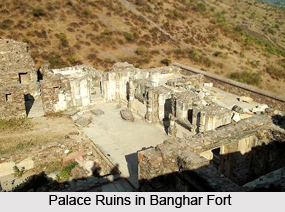 Banghar fort, situated in Alwar district of Rajasthan, is an ancient fortified town, presently in ruins. Built in 17th century, the place has been abandoned since ages owing to its uncanny reputation of being haunted. However the relics of past have still been well preserved within the fort campus by the Archaeological Survey of India. Through years, Banghar fort has been the constant captive of a bizarre creepiness, the origin of which is enrooted in some local legends and beliefs. It also prohibits the entry of visitors into the premises between the period of sunset and sunrise. Outside the fort precincts a new village, known as Bangarh, has developed over time with a considerable population.
Banghar fort, situated in Alwar district of Rajasthan, is an ancient fortified town, presently in ruins. Built in 17th century, the place has been abandoned since ages owing to its uncanny reputation of being haunted. However the relics of past have still been well preserved within the fort campus by the Archaeological Survey of India. Through years, Banghar fort has been the constant captive of a bizarre creepiness, the origin of which is enrooted in some local legends and beliefs. It also prohibits the entry of visitors into the premises between the period of sunset and sunrise. Outside the fort precincts a new village, known as Bangarh, has developed over time with a considerable population.
History of Banghar Fort
The territory of Banghar fort, which is presently under the Thana Ghazi tehsil, was previously ruled by the Rajawats, the descendents of Raja Bhagwant Singh of Amer. The palaces and temples which stand in the fortified town were built by them. Currently the descendents of this lineage are the residents of nearby villages and are cultivators by profession who exhibit their royal origin through their demeanours. Madho Singh who was the son of Man Singh of Amber, a Mughal army general, had constructed the fort in 17th century which served as their capital city.
Legends of Banghar Fort
The devastation and eeriness of the fort have been explained by two versions of a local legend. According to the first version, a wizard named Scindia used to dwell in the fort area in ancient times.
 He had commanded that no house in the district must be taller than his own and in case the shadow of any house falls over his house, the fort town would demolish. The second version of the legend states that the wizard was a connoisseur of black magic and was in love with the beautiful princess of Banghar. Once, while the princess went to the market with her friends for buying a scent, Scindia replaced the scent with a potion which had the power of ensnaring the princess. When he offered the scent to the princess in the hope of attracting and eventually marrying her, she saw through his trick and threw off the potion on a nearby big boulder. Consequently, the boulder got attracted and rolled towards the wizard, crushing him. However, before succumbing to death he cursed that the fort would soon be destroyed and no one would be able to live within the premises. Following the curse, the neighbouring kingdom of Ajabgarh invaded the fort and in a fierce battle killed all the inhabitants along with the princess. Since then a persistent belief prevails that the present condition of Banghar fort owes to the curse of the wizard and the place is haunted by the spirits of the deceased people.
He had commanded that no house in the district must be taller than his own and in case the shadow of any house falls over his house, the fort town would demolish. The second version of the legend states that the wizard was a connoisseur of black magic and was in love with the beautiful princess of Banghar. Once, while the princess went to the market with her friends for buying a scent, Scindia replaced the scent with a potion which had the power of ensnaring the princess. When he offered the scent to the princess in the hope of attracting and eventually marrying her, she saw through his trick and threw off the potion on a nearby big boulder. Consequently, the boulder got attracted and rolled towards the wizard, crushing him. However, before succumbing to death he cursed that the fort would soon be destroyed and no one would be able to live within the premises. Following the curse, the neighbouring kingdom of Ajabgarh invaded the fort and in a fierce battle killed all the inhabitants along with the princess. Since then a persistent belief prevails that the present condition of Banghar fort owes to the curse of the wizard and the place is haunted by the spirits of the deceased people.
Features of Banghar Fort
Banghar fort stands in the foothills of Aravalli range, on a sloping terrain. On entering the fort through the main gate, ancient palaces and temples can be witnessed. Apart from this, the fort has four more gates known as the Delhi Gate, the Phulbari Gate, the Ajmeri Gate and the Lahori Gate. The plethora of temples in the fort premises comprises Naveen Temple, Ganesh Temple, Mangla Devi Temple, Keshav Rai Temple, Someswar Temple, Gopinath Temple and Hanuman Temple. Among all, Gopinath Temple is a prominent one which is constructed above a raised plinth of 14 feet height. Magnificent carving of yellow stone adorns the temple. Inside the temple complex, the residence of priest is also located which is popularly known as `Purohitji ki Haveli`. Following Gopinath Temple, a market place called "Jauhari Bazar" and the "Dancers` Haveli" are situated. At the extremity of the fort precincts, the royal palace stands. Mahadev and Hanuman temples exhibit an elegant architecture with Jhirri marble, although their preservation is much needed. Its architectural style resembles more a cenotaph than a temple.




